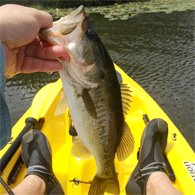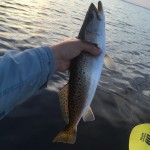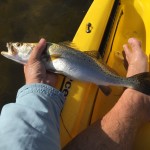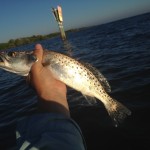
One of the best kayak fisheries for Speckled Sea Trout (trout) in the United States is the Mosquito Lagoon. The vast grass flats are a perfect habitat for trout to ambush its prey while also providing great sight fishing opportunities for anglers.
Where to Find Trout
Trout can be found through out the Mosquito Lagoon all year. They are found in water as shallow as 6″ and are also found in the deepest parts of the lagoon, the channel (12-14′ deep), making them a great target for kayak fishing. Most trout that are caught on the lagoon are found on the grass flats in water 10″ to 3′ deep. When sight fishing is possible (when the sun is high and the water is clear) anglers drift the open flats in search of either the tell-tail silver body of a trout of a sandy pot hole in the middle of the grass.
The pot holes look like sandy circles or ovals that range in size from a few inches wide to the size of a small car. Trout hide in the grass just outside of these potholes waiting to ambush any prey that wanders into the opening.
Equipment for Catching Trout
The average trout caught in Mosquito Lagoon has no specific gear requirements. They are only about 2lbs and due to the lack of hard structure though out most of the lagoon, almost any saltwater rated gear will work well. For the larger fish, 10lb test rated gear will work just fine and are quite a fun fish to catch from a kayak.
The most popular rig for trout fishing in mosquito lagoon is a spinning real in the 2000-3000 class spooled with 10lb test braid with a 12-15lb fluorocarbon leader. I medium action rod that is 7’6″ will aid in casting distance but any rod over 6′ will do just fine.
How to Catch Trout
Trout are willing strikers of artificial lures and live bait alike.
Artificial Lures
Early morning (just after sunrise) and late afternoons (just before sunset) trout are some of the most spectacular top-water lure strikers. They explode on top-water lures with a splashy, vicious hit, making this one of the most popular and exciting methods of catching trout. Any walk-the-dog type lures (ie Zara Spook Jr.) produce well when worked over the flats. Use a slow, but active retrieve. Once a fish hits, do not set the hook until pressure is felt as trout tend to miss the lure on first attempt. If the fish does miss, stop the lure for a second then continue the presentation. Trout have been known to strike a top-water many times in a row.
Paddle Tails, Curl Tail (grub type), and jerk baits top the list for soft plastic lures. The best presentation for paddle tails and grubs is to swim them just above the grass until they are over top of a pot hole. Allow the lure to drop into the pothole, jigging it up and down with a slow retrieve through the length of the pothole. Once at the end of the pothole, swim the lure above the grass again until back at the kayak or to the next pothole. Jerk baits are presented in a similar manner, using a standard jerk bait presentation above the grass, but allow the lure to fall into the potholes from time to time. This will trigger the trout to strike!
Live Bait
While the majority of trout caught kayak fishing in Mosquito Lagoon are caught on artificial lures, some prefer to use live bait. The top baits for trout are Finger Mullet, Live Shrimp and small Pinfish. When using live bait there are two main techniques to use, sight fishing and free-lining.
Live Bait Sight Fishing
The best rig for sight fishing for trout using live bait is to use a light wire, 2/0-3/0 circle hook with no weights or swivels attached to the line. When a trout is spotted, cast the live bait beyond the fish and slowly rretrievethe bait until it is in the strike zone. Once in the strike zone, allow the bait to move freely, this natural action will trigger a strike. Once the fish hits allow a second or two the start to reel in while holding the rod tip high (do not “set the hook” with circle hooks.
Live Bait Free-Lining for Trout
Another good technique for catching trout from a kayak is to free-line the live bait in areas known to hold trout. Areas such as potholes (mentioned above) and edges of grass flats where they meet deeper water.
Using a 2/0-3/0 circle hook and no other terminal tackle, cast the bait into the pothole or the grass edge. Allow the bait to move naturally around the area, do not keep the line tight. To detect a strike watch the line close, any change in direction, or rapid movement could be a fish on. Slowly reel in the slack, if there is pressure on the other end, raid the rod tip and reel in the fish!
Florida Trout Regulations
- Slot: 15-20″ (allowed 1 over 20″ per day)
- Bag Limit: 4-6 depending on Zone (See FWC)
- Season: Open year-round
- Regulations accurate as of 1/5/2015
___________________________________





Comment here